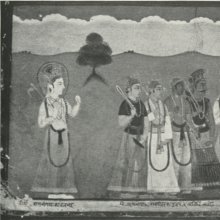Pancapandava, Pancan-pandava, Pāñcapāṇḍava: 2 definitions
Introduction:
Pancapandava means something in Jainism, Prakrit, the history of ancient India. If you want to know the exact meaning, history, etymology or English translation of this term then check out the descriptions on this page. Add your comment or reference to a book if you want to contribute to this summary article.
Alternative spellings of this word include Panchapandava.
Images (photo gallery)
In Jainism
General definition (in Jainism)
Source: academia.edu: Tessitori Collection IPāñcapāṇḍava (पाञ्चपाण्डव) refers to one of the 157 stories embedded in the Kathāmahodadhi by Somacandra (narrating stories from Jain literature, based on the Karpūraprakara), which is included in the collection of manuscripts at the ‘Vincenzo Joppi’ library, collected by Luigi Pio Tessitori during his visit to Rajasthan between 1914 and 1919.—The Kathāmahodadhi represents a repository of 157 stories [e.g., Pāñcapāṇḍava] written in prose Sanskrit, although each of them is preceded by a verse. Together, they stage a large number of Jain characters (including early teachers). [...]

Jainism is an Indian religion of Dharma whose doctrine revolves around harmlessness (ahimsa) towards every living being. The two major branches (Digambara and Svetambara) of Jainism stimulate self-control (or, shramana, ‘self-reliance’) and spiritual development through a path of peace for the soul to progess to the ultimate goal.
India history and geography
Source: Heidelberg: Glory of the Tiruvanantapuram Padmanabhasvami TemplePañcapāṇḍava (पञ्चपाण्डव) or Pañcapāṇḍavatīrtha refers to a group of Tīrthas (“sacred water-bodies”) mentioned in the Anantaśayanakṣetramāhātmya, a text talking about the Thiruvananthapuram temple in eleven chapters, written before the 14th century and claiming to be part of the Brahmāṇḍapurāṇa.—A māhātmya usually describes the Tīrthas (sacred water-bodies) in the surroundings of the centres that figure in that māhātmya. In the eleventh chapter Anantaśayanakṣetramāhātmya, too, we find a list of Tīrthas around the Tiruvanantapuram Temple [e.g., Pañcapāṇḍava-tīrtha] describing its legends and glory.

The history of India traces the identification of countries, villages, towns and other regions of India, as well as mythology, zoology, royal dynasties, rulers, tribes, local festivities and traditions and regional languages. Ancient India enjoyed religious freedom and encourages the path of Dharma, a concept common to Buddhism, Hinduism, and Jainism.
See also (Relevant definitions)
Partial matches: Pandava, Panca.
Starts with: Pancapandavatirtha.
Relevant text
No search results for Pancapandava, Pāñcan-pāṇḍava, Pancan-pandava, Pāñcapāṇḍava, Panca-pandava, Pāñca-pāṇḍava; (plurals include: Pancapandavas, pāṇḍavas, pandavas, Pāñcapāṇḍavas) in any book or story.
